Types of Metal Detecting Activities, page 22:
WET SAND BEACH HUNTING
(CONTINUED from previous page)
Metal Detectors Required for Beach Hunting on Wet Sand and in Shallow Surf
Since the salt concentrations are higher in wet sand than in dry sand, only VLF metal detectors with Automatic Ground Balance and Tracking options (for ignoring salt water and magnetic sand simultaneously) will perform well. All BBS and FBS detectors will do great, and sometimes, along with PI detectors, may be the only machines to perform effectively on wet sands with high concentrations of iron magnetite.
When it comes to shallow surf wading, only amphibious, wading and underwater metal detectors, both BBS and PI types, can and should be used. PI detectors have an advantage over other types in relation to the detecting depth and ignoring both salt mineralization and black magnetic sand.
Using the Pulse Induction Underwater Metal Detector for Wading in Surf
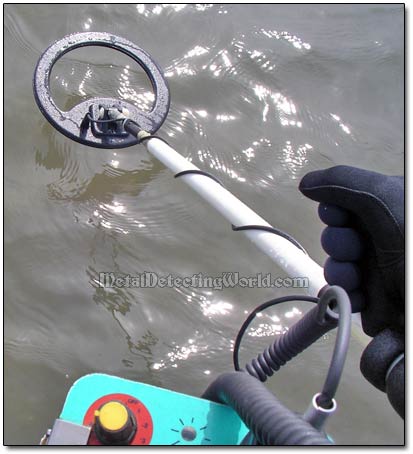
But the multi-frequency BBS metal detectors, such as the most popular models of the Minelab's Excalibur line, are more comfortable and easier to operate because of the Multi Tone ID, Automatic Tuning (Auto Tune) and Discrimination options. The latter plays an important role when wading into the shallow surf at the locations which contain a lot of trash and iron.
However, this can be the "Catch 22" since discriminating iron may lead to missing too many valuable targets positioned beneath it. Like at any hunt site on land, most of the beach junk is ferrous (iron) by virtue of its availability. There are some beaches that may be littered with so many iron objects that they form a layer or "trash blanket." All valuable targets lying in close proximity to iron objects or beneath them are completely masked to any metal detector, so this "trash blanket" may conceal a lot of small "treasures" beneath it.
Auto Tune or S.A.T. (Self Adjusting Threshold) also plays a very important role in metal detector's performance during wet sand/surf hunting. When used at the surf line, where the search coil is in and out of salt water, a manually tuned metal detector can be very frustrating to use. The control must be adjusted continually to maintain a threshold. Some detectorists set it slightly below the threshold; however, that can result in a reduction in depth as the ground conditions change.
Automatic tuning helps keep the metal detector operating at maximum sensitivity without requiring constant adjustments by the operator. It improves the stability, reduces noise, and allows higher Gain settings to be used.
Equipment and Accessories Used for Beach Hunting on Wet Sand and Wading in Shallow Surf
• Dry Suits are essential for wading in the shallow surf because they are designed to prevent water entering and provide thermal insulation or passive thermal protection to the wearer while immersed in water for long periods of time. It is important to remember that the body loses heat much faster in the water than in the air. Staying immersed into the water without proper thermal insulation for hours may turn your Treasure Hunting Day into the Ambulance Ride Day.
• Submersible Search Coils are the must if you plan to search the wet sand with a land metal detector. Search coils of most land metal detectors are submersible.
• The electronics housing must be either water-resistant (splashproof metal detectors) or waterproof (underwater metal detectors) if you plan to venture into the shallow surf. The waterproof encasing for the control box is the must if you use a land metal detector in the shallow surf.
• Headphones are required to hear the faint and tiny signals and to minimize the sounds of winds, splashing waves and people.
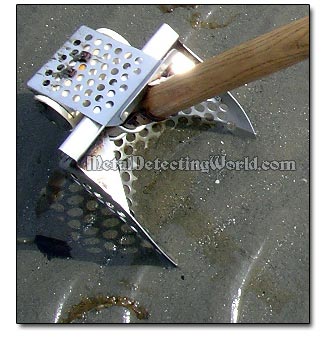
• Sturdy short-handle Sand Scoop made of steel is good for detecting on wet sand, but a long-handle water scoop is even better as it would give you a better leverage. Because it takes a few moments to work damp sand out of a beach scoop, it takes some practice to get used to it, but you will build the muscle and master your recovery technique after a while. Recovering targets on wet sand requires sturdy metallic scoops. The light plastic and short-handled beach scoop used for detecting on dry sand is out of question because the wet sand is dense and heavy.
A long-handled Water Scoop is required for shallow surf hunting as you most likely would not want to kneel or bend down in the water to recover a target. Water scoop differs from the sand scoop by the following features in its design: 1) a foot pad behind the handle (as shown on picture to the right), on which you place your foot for proper leverage during target recovery, 2) pointed front for easier digging through wet sand and rocky ocean or sea floor, 3) wood handle that floats, 4) open top allowing you to see and retrieve your finds quickly. Water scoop also may have either a balance grab handle welded to the scoop handle or plastic lift handle which can be attached to the scoop handle, so one can pick up the scoop easier when it is filled with sand. To keep the scoop pointing in the right direction, you should mark the handle.
Some beach hunters prefer the water scoops that are made completely of steel so they would not quickly float away in the current. Well, a water scoop with a long wood handle does float, and its handle is usually standing upright, but such a scoop eliminates a problem associated with keeping a metallic long-handled scoop far enough away from the search coil if a sensitive metal detector is used. Plus, when the wood handle breaks, it can be easily replaced.
• Side Beach Basket/Sifter is also very useful for wet beach hunting. It is designed to be worn on either side of your hip to dump wet sand into basket. As you shake the basket a few times, the wet sand is quickly sifted through the mesh screen while everything else stays in the basket. It has an aluminum backing with a sand reflector to toss the sand away from your body. A side beach basket can be purchased or easily made at home.
• Pulse Induction (PI) Pinpointer, something like a waterproof Vibra Probe 580, will save you lots of time during target recovery, and without malfunctioning that may be caused by salt concentrations in wet sand. Unlike the VLF pinpointers, the PI pinpointer is able to ignore conductive salt "pockets" in wet sand and surf.
• Floating Self Sifter will save you lots of time and efforts during recovering and sorting out the targets while standing in deep water. When you empty your scoop into the sifter, the sand and soil are quickly sifted through, leaving behind junk, coins, and jewelry. If you attach a cord from your belt to the sifter, it will follow you. You can purchase a Heavy Duty Plastic Self Sifter with a durable rubber inner tube or make one yourself.
Homemade Floating Self Sifter
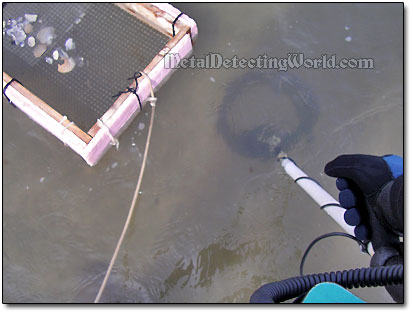
Water Scoop Contents Emptied on a Floating Sifter
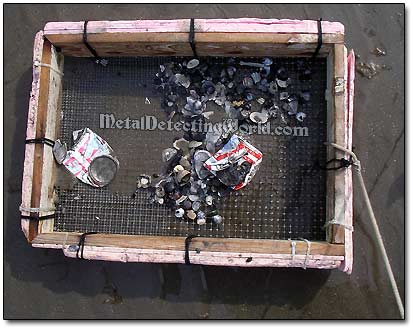
• 3-Compartment Pouch is used to keep your "keeper" beach finds - silver and gold jewelry and coins, separately. The pouch should be waterproof to prevent soiling your clothes and sturdy enough to hold plenty of weight.
• Weight Belt with about 30lbs of lead to keep your footing. You can choose such a belt from a variety of weight belts available on the market. Or you can easily make one by sewing up a canvas tube with velcro closures and with a velcro or other waist securing catch, then filling it with sand. Though it could be a little bulky, it would beat wading with a weight belt. A weight belt is essential if you are wading waist deep in surf that has waves about 2-3 feet or strong side currents. Without a weight belt, you will be thrown all over the place, and it will be hard to stay in one spot for more that a second or two. Also standing sideways to the surge might help.
• Search Coil Stabilizer to keep the coil from being tilted up by the surf or bottom contact.
• Neoprene Chest Waders (neoprene is the warmest) which are 5 mm thick. Wear a good pair of thermals underneath and add a layer or two on top. Always keep extra socks and clothes in your pack or vehicle for accidents or emergencies.
• For your hands, use a good pair of Waterproof Neoprene Gloves.
• When you search in the water up to your chest, you should wear at least a hat of bright color, so the people on paddle boats, canoes, jet skis, sailboards and surfboards could see you - just a simple safety precaution. Also watch where you step! Stone fish, spiney urchins, and cone shells can be harmful when bothered.
The latter can harpoon from a couple of inches away; and their venom may cause a respiratory failure. However, they are fine if left alone. Same goes with the stone fish. Its dorsal fin has venomous spines that can harm you.
• When detecting the wet sands along the river banks, a strong, thin digger-like screwdriver is needed for recovering targets that may be stuck within a complicated root structure beneath trees and tree stumps. A regular treasure hunting shovel is used for recovering targets from the heavy river mud mixed with stones. A pair of Hip Waders or high rubber boots is recommended.Tens of thousands of valuables are continuously lost each year on salt- and freshwater beaches, and you can start finding them!
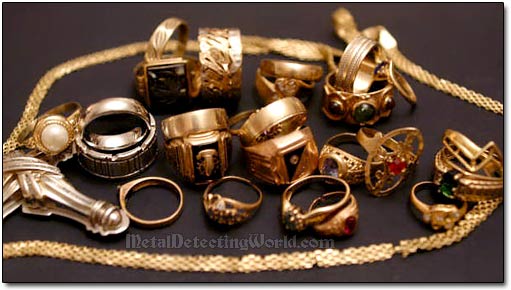
To see what metal detectors for this metal detecting activity are available on the market today and read their reviews, you might want to visit my page on Metal Detectors for Beach/Surf/Underwater Treasure Hunting.
Make a Donation
Please help me stay afloat, afford more metal detecting trips with field-tests and experiments to create more informative articles, useful tutorials and helpful guides for detectorists, and maintain this website - the most informative hobby resource on the web! Since I do not have any steady income, any donation matters to me a lot! Thank you kindly!
Clicking on the donate button will take you to a donation page powered by Donorbox and dedicated to my website (MetalDetectingWorld.com). The donation page is PCI-compliant, secured by SSL/TLS, and has a simple form to fill out. Donorbox does not store any card or bank data. Credit card information is encrypted and tokenized by the Stripe payment processor.
This website would not exist without the advertisements we display and your kind donations. If you are unable to support us by viewing our advertisements, please consider making a Donation to ensure the future of this website. By helping me keep this website alive and growing, you will sure help many detectorists around the world as well!
ANNOUNCEMENT:
In January of 2020, I started a one-time fund-raising campaign in attempt to accumulate enough money to buy a simple but reliable 4x4 vehicle. My old 4x4 car (made in 1995) had faithfully served me for 10 years before it eventually went beyond repair last October. Without a 4WD, I will not be able to get to my hunt sites and test-plots hidden in the remote wooded areas inaccessible by a regular car.
Unlucky for me, those sites are the only locations available and suitable for my field-work which results in informative articles you can find on this website. For the past 10 years, my usual field-work has consisted of field-testing the latest metal detectors and accessories, experimenting with some of them, and devising new effective search methods that meet the requirements of the new metal detecting reality.
Before my car died, I managed to finish a couple of interesting detector-testing projects which will be covered in my upcoming articles. But other equally important projects that I was working on were not completed and had to be postponed until the Spring 2020. I hope that this fund-raising campaign will help me get a decent 4x4 by then so that I will be able to resume my work and to write more new articles, tutorials and guides based on data gathered through testing and experimentation.
If you find my website useful and would like it to provide more essential info for you and other detectorists worldwide, please consider chipping in $5, $20, $50 or whatever you can afford to keep MetalDetectingWorld.com growing in 2020. I promise you, it will be money well spent. Thank you.
Donate- Please help me promote this article:
If you would like to follow me on Twitter, please press a button:
I have my profile page on
where you can share your thoughts on this article, ask me a question, or place a friend request.I also have my profile pages on Pinterest, LinkedIn, Tumblr, Reddit and Delicious
and my "Metal Detecting World" page on Twitter, Pinterest and Tumblr
I no longer maintain my old Facebook page